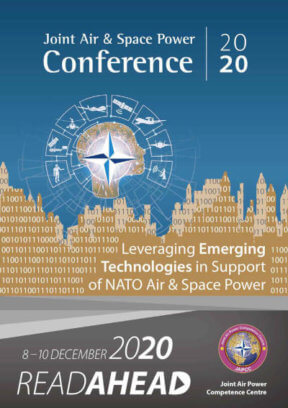Introduction
Many of today’s military conflicts are still largely contested with predominately Industrial Age forces and mind-set … both of which are increasingly changing. The exponential growth in technology, coupled with increasing applications, and understanding, of those technologies is rapidly changing the tools we use in our daily lives and in the conduct of military operations. As NATO transitions more firmly into the Information Age, the tools it utilizes to address security issues and ensure the safety of the Alliance have the potential to increasingly alter the way in which NATO goes about its business. Artificial Intelligence (AI), of the Narrow variety, has for years provided protection for NATO aircraft and tanks in the form of radar warning receivers and reactive armour. While the applications of Narrow AI will continue to grow, the possibility of General AI (AI that can perform a wide variety of functions) will present new opportunities as well as new challenges. NATO has already begun to ponder how it will both utilize and react to weapons systems exploiting hypersonic technologies, and those concerns are certain to increase with time. As capabilities continue to provide increased speed and reach, the ability to test and train with those capabilities will force the need to develop synergies between live, virtual, and constructive ranges which allow for simulations to provide realistic scenarios involving the full spectrum of capabilities … as they emerge. With continued advancement of technologies and capabilities, the need to establish an appropriate balance of human control over AI will drive the Observe, Orient, Decide, Act (OODA) loops to meet requirements, maintain a competitive advantage, and ensure human responsibility and safety.
Artificial Intelligence
The term AI is commonplace today, so common that many are not aware of the different types of AI or even that there are different types of AI. The type of AI most of us interact with daily is referred to a Narrow, or Weak, AI. This type of AI is focused on specific, or narrow, tasks and is exclusively good at them. For example, in December 2017, computer programmers working for Google, on a program titled AlphaZero, reached a programming milestone. ‘Starting from random play, and given no domain knowledge except the rules, AlphaZero achieved within 24 hours a superhuman level of play in the games of chess and shogi (Japanese chess) as well as Go, and convincingly defeated a world-champion program in each case’1. Still, AlphaZero, world-champion of chess, shogi and Go, is incapable of vacuuming your living room as it is simply not programmed to deal with that task. Conversely, General, or Strong, AI is programmed to accomplish a wide variety of tasks. This type of AI is the type portrayed in science fiction movies with anthropomorphic androids (robots) threatening human existence; or at least that of the protagonist. More importantly, this type of AI does not yet exist in any meaningful way outside of a laboratory. Even self-driving cars being tested on roads around the world are incapable of making toast and are therefore categorized as Narrow AI.
Militarily speaking, it is important to note these differences. Often when AI is being discussed in military conversations focused on new and emerging technologies, any concerns expressed are usually in relation to General (Strong) AI. The concerns surrounding the development of General AI have been sounded for decades by the likes of Ray Kurzweil, such as in his 2006 The Singularity is Near: When Humans Transcend Biology, Nick Bostrom’s 2014 Superintelligence: Paths, Dangers, Strategies, and most recently P.W. Singer and August Cole’s 2020 book Burn-In: A Novel of the Real Robotic Revolution. As AI continues to develop and evolve, military leaders and planners will need to remain cognizant of, and able to articulate, the differences between the capabilities currently available and those still on the proverbial drawing board.
Hypersonic Capabilities
Hypersonic research programs have existed in the US and Russia (Soviet Union) going back as far as at least the 1980s but have recently seen renewed interest and public speculation. At present there are two types of hypersonic weapons: hypersonic cruise missiles and hypersonic glide vehicles. With hypersonic cruise missiles the missile is self-propelled at extremely high speeds (five times the speed of sound or more), while hypersonic glide vehicles are launched from a rocket, then detach at altitude and glide to their intended target.
Whereas hypersonic technology was sought after by relatively few during the Cold War, today many countries are pursuing the technology for both offensive and defensive means, including the US, Russia, China, France, Germany, Australia, and India. It is also important to note that speed is not the only reason this technology is being pursued. Hypersonic weapons are also distinctly manoeuvrable, with the ability to ‘use aerodynamic forces to manoeuvre laterally to targets hundreds of kilometres away from the location indicated by the bearing of their initial launch.’2
Live, Virtual, & Constructive Training Ranges
As new military technologies emerge, many with the operational reach measured in hundreds if not thousands of miles, they have to be tested and trained with on ranges capable of accommodating their operational capabilities. Coupled with the need for operational and technical security, it is neither feasible nor practicable to test and train these emerging systems on legacy ranges. Hence the integration of Live, Virtual and Constructive (LVC) test and training opportunities. The live element is the traditional open-air ranges where systems have the freedom to manoeuvre and operate in simulated scenarios, i.e., two fighter aircraft engaging in an in-flight simulated air-to-air combat. The virtual element involves systems which simulate not just scenario, but also the capabilities being tested or trained, i.e., two pilots utilizing flight simulators to engage one another in simulated air-to-air combat. The third element of LVC, constructive, involves computer-generated entities to represent various systems or platforms, i.e., one pilot utilizing a flight simulator to engage a computer-generated pilot in simulated air-to-air combat.
In the future, AI will be used to assist with battlespace management across multiple operational domains. These operations will witness hypersonic weapons engaging targets from thousands of miles supported, or supporting, attacks by a host of different AI’s through cyberspace. Sensors in orbit will communicate directly with operators on the ground and sea, as well as unmanned systems operating in the air and under the water. And all of this will require coordination and synchronization that can only be produced through testing and exercises … which will require ranges capable of supporting any and all compositions of existing and emerging technologies.
Additional Articles
This section presents four related articles which will introduce various ideas and issues related to future technological developments, and the various issues NATO may face while incorporating or facing these capabilities. The ideas expressed in these articles are meant to prepare those attending the 2020 Joint Air & Space Power Conference for the panel discussion on Future Developments:
Kill the Enemy and Don’t Forget to Buy Milk on the Way Home is written by Group Captain Jo Brick (AUS Air Force). This paper focuses on technologies which enable military operators to execute their missions from the homefront, thus blurring the lines between war and peace.
Dr. Cathy Moloney’s Hypersonics: Changing the NATO Deterrence Game appears next in the booklet. The paper examines NATO’s approach to deterrence with respects to potential adversaries, and the Alliance’s approach might shift with the fielding of hypersonic capabilities.
Implications of 5G to Air Power: A Cybersecurity Perspective is a work by Major Fotios Kanellos (GRC Air Force). This paper discusses the potential impacts to air power in the age of 5G networks, particularly as this new technology pertains to cybersecurity of air forces.
The final Future Developments Panel paper is, Forecasting Change in Military Technology, 2020–2040. This is an abridged executive summary of Michael E. O’Hanlon’s comprehensive study looking at changes in military technology during the next two decades. The excerpt touches the highlights of a well-research study intended to inform military planners and operators preparing for future conflicts.









